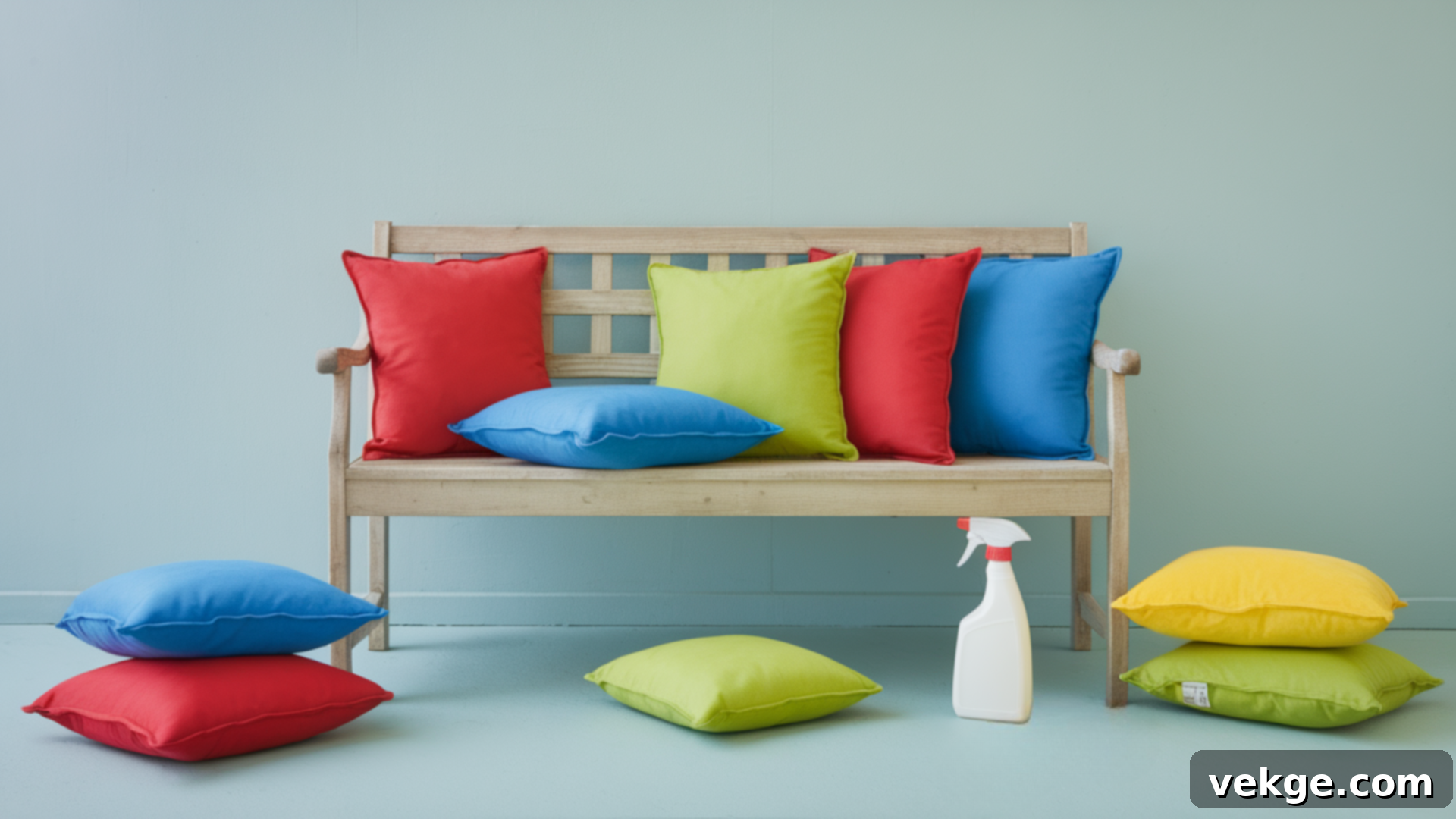The Ultimate Guide to Cleaning Outdoor Cushions for a Fresh Patio
Your outdoor living space is an extension of your home, a place to relax, entertain, and enjoy the fresh air. Central to its comfort and appeal are your outdoor cushions. While they provide much-needed comfort and a touch of style, these cushions face constant exposure to the elements – sun, rain, dirt, pollen, and even the occasional spilled drink. Over time, this exposure can lead to a dull, dirty, and uninviting appearance.
Cleaning outdoor cushions might not be the most exciting chore on your list, but it’s a game-changer for your patio’s aesthetics and your cushions’ longevity. Regular maintenance doesn’t just refresh their look; it actively extends their lifespan, protecting your investment and ensuring your outdoor oasis remains a welcoming retreat. This comprehensive guide will walk you through easy, effective methods to clean your patio cushions, remove stubborn stains and mildew, and implement preventative care tips to keep them looking pristine for years to come.
The Undeniable Importance of Cleaning Outdoor Cushions
Beyond simply making your patio furniture look good, there are several compelling reasons why keeping your outdoor cushions clean is essential. It’s a fundamental part of maintaining a healthy, appealing, and durable outdoor living space.
- Enhances Appearance and Comfort: Clean cushions immediately brighten your patio, making it more inviting and pleasant for you and your guests. Over time, dirt, dust, and environmental grime can dull colors and make fabrics feel rough or sticky. Regular cleaning restores their vibrancy and softness, transforming your outdoor space into a comfortable haven.
- Prevents Mold and Mildew Growth: Outdoor environments are a breeding ground for mold and mildew, especially in damp conditions. These fungi not only look unsightly and produce unpleasant odors but can also cause allergic reactions and respiratory issues. More critically, mold and mildew can degrade cushion fabric over time, leading to irreparable damage and a need for costly replacements. Consistent cleaning is your best defense.
- Extends Cushion Lifespan: Dirt and grime can act as abrasives, wearing down fabric fibers with every use. Stains, if left untreated, can become permanent, while mildew can literally eat away at the material. By regularly cleaning and properly caring for your outdoor cushions, you protect their fabric integrity, preserve their colors, and significantly extend their usability, ultimately saving you money in the long run.
- Maintains Hygiene: Outdoor cushions collect more than just visible dirt. They can harbor allergens like pollen, dust mites, and even pet dander. Cleaning them ensures a more hygienic surface, contributing to a healthier environment for everyone enjoying your outdoor areas.
- Protects Your Investment: Quality outdoor cushions can be a significant investment. Treating them with care and performing routine maintenance ensures you get the most value from your purchase. Think of it as protecting a valuable asset that contributes greatly to your home’s comfort and curb appeal.
Before You Begin: Understanding Your Cushion Fabric
Before diving into the cleaning process, take a moment to understand the material your cushions are made from. Most outdoor cushions are crafted from durable, weather-resistant fabrics like acrylic (e.g., Sunbrella), polyester, olefin, or cotton blends. Checking the manufacturer’s care label is always the best first step, as it provides specific instructions that can prevent damage. While the general cleaning steps below apply to most outdoor fabrics, knowing your material helps you choose the gentlest yet most effective approach.
Essential Materials for a Sparkling Clean
Gathering your tools before you start makes the cleaning process much smoother and more effective. Here’s what you’ll need for a thorough outdoor cushion cleaning:
- Vacuum with Upholstery Attachment: Essential for removing loose dirt, dust, leaves, and other debris that accumulates on the surface and in crevices. A powerful vacuum ensures you don’t turn dry dirt into mud during the wet cleaning stage.
- Soft Bristle Brush: A brush with soft bristles is crucial for gently scrubbing away embedded dirt and stains without damaging or abrading the fabric. Avoid stiff brushes, which can harm the fibers.
- Mild Liquid Soap: Dish soap (like Dawn) or a gentle laundry detergent works perfectly. The key is to use a mild, pH-neutral soap that won’t strip protective coatings or bleach colors.
- Warm Water: Warm water helps dissolve soap more effectively and aids in lifting grime.
- Bucket(s): For mixing your cleaning solution and rinsing.
- Spray Bottle or Garden Hose with Nozzle: A spray bottle is great for applying solution to smaller areas, while a garden hose is ideal for thorough rinsing of larger cushions.
- Clean Towels or Microfiber Cloths: Useful for blotting up excess moisture or spot cleaning.
- Optional (for stubborn issues):
- White Vinegar: An excellent natural deodorizer and mild disinfectant, effective against mold and mildew.
- Baking Soda: Great for absorbing odors and tackling light stains.
- Hydrogen Peroxide: For tougher mold and mildew stains on light-colored fabrics (use with caution and spot test).
Step-by-Step Guide to Deep Cleaning Your Outdoor Cushions
Follow these steps to give your outdoor cushions a thorough cleaning, restoring their freshness and vibrancy.
Step 1: Prep & Pre-Clean (Remove Loose Debris)
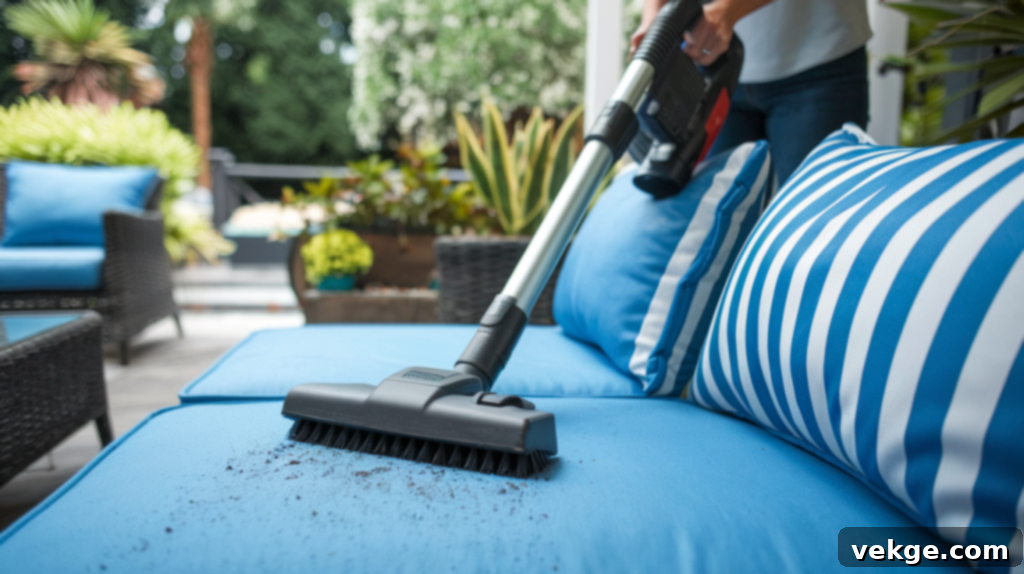
Before any wet cleaning, it’s crucial to remove all loose dirt and debris. Take your cushions off the furniture and give them a good shake or beat them to dislodge trapped particles. Then, use your vacuum cleaner with an upholstery attachment to thoroughly vacuum both sides of the cushions, paying special attention to seams, corners, and any tufted areas where debris tends to collect. This prevents dirt from turning into muddy streaks once you introduce water and ensures your cleaning solution can penetrate the fabric effectively.
Step 2: Crafting Your Gentle Cleaning Solution
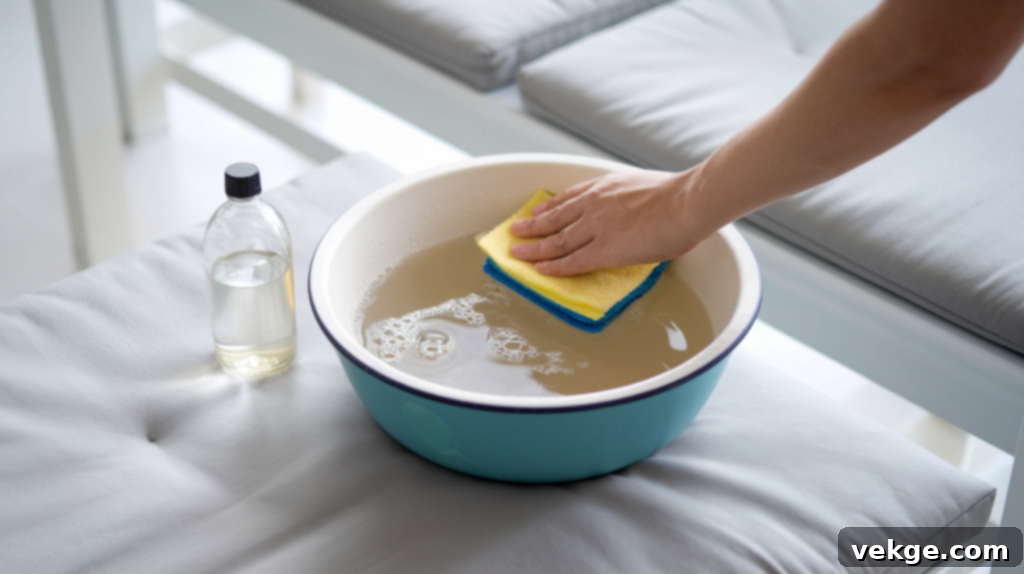
In a bucket, mix a small amount of mild liquid soap (about 1/4 cup) with a gallon of warm water. Stir until suds form. For areas with visible mold or mildew, or strong odors, you can add about 1/2 cup of white vinegar to this solution. Before applying the solution to the entire cushion, always perform a spot test on an inconspicuous area (like the underside or back seam). This ensures the solution won’t cause discoloration or damage to your specific fabric type.
Step 3: The Scrubbing Technique for Spotless Fabric
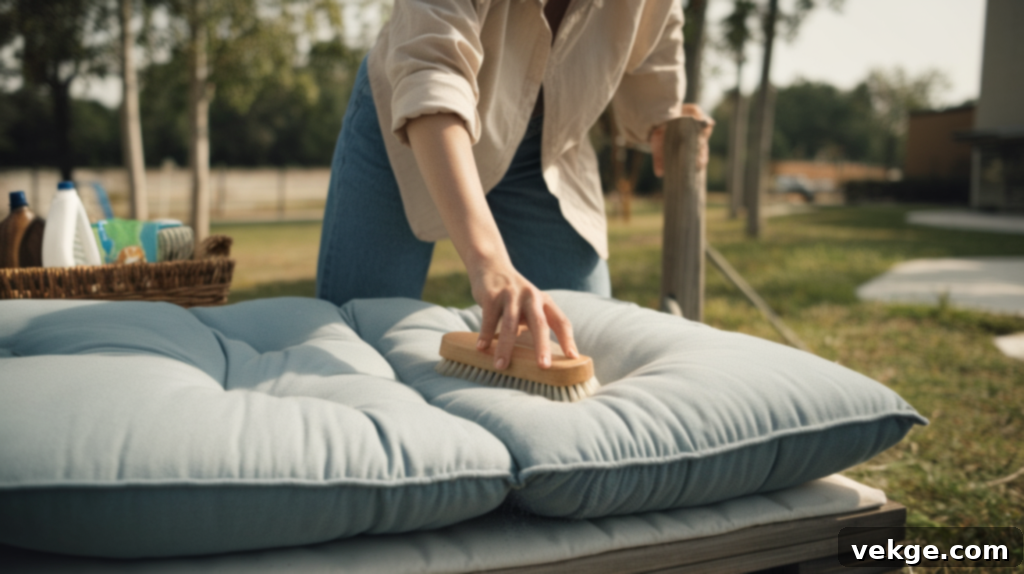
Using your soft-bristle brush, gently apply the cleaning solution to the entire surface of the cushion, working in small sections. Scrub in gentle circular motions, focusing on areas with visible dirt, stains, or mildew. The soft bristles will help lift the grime without abrading the fabric. Avoid excessive scrubbing or using too much pressure, which can damage fibers or push dirt deeper into the material. For cushions with removable covers, you might be able to remove them and wash them according to their care label, but for integrated cushions, this method is ideal.
Step 4: Rinse Thoroughly and Ensure Complete Drying
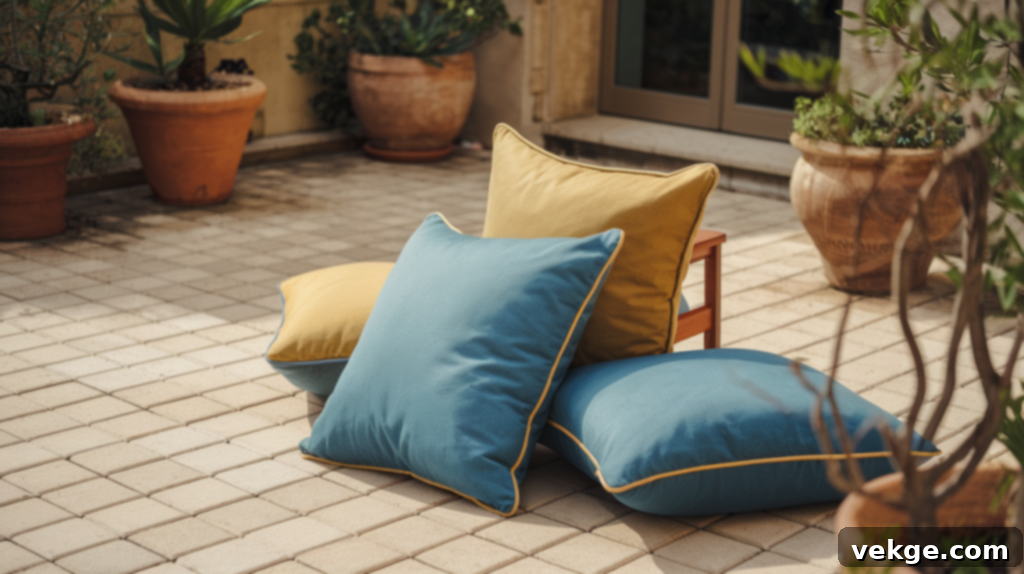
Once you’ve scrubbed all surfaces, thoroughly rinse the cushions with a garden hose or a spray bottle filled with clean water. It’s crucial to remove all soap residue, as any left behind can attract new dirt more quickly and potentially cause fabric stiffening. Continue rinsing until the water runs clear and no suds are visible. After rinsing, stand your cushions upright or prop them on their sides to allow excess water to drain out efficiently. Press down gently on them to help expel water from the foam core. Then, let them air dry completely in a sunny, well-ventilated area. Drying thoroughly is paramount; incomplete drying is the primary cause of mold, mildew, and unpleasant odors returning. Depending on humidity and sunlight, this could take several hours or even a full day. Ensure they are bone-dry before putting them back on your furniture or storing them.
Targeting Tough Troubles: Effective Solutions for Stubborn Stains
Even with regular cleaning, stubborn stains can appear. Here’s how to tackle common types of tough stains on your outdoor cushions, remembering to always spot test first:
- Mold & Mildew Stains: For persistent mold and mildew, a mixture of equal parts white vinegar and water is highly effective. Spray it directly onto the affected area, let it sit for 15-30 minutes, then scrub gently with a soft brush and rinse thoroughly. For very stubborn black spots on light-colored fabrics, a diluted solution of hydrogen peroxide (1 part peroxide to 2 parts water) can be carefully applied. Let it sit for a few minutes, then scrub and rinse.
- Oil/Grease Stains: Act quickly! Blot as much of the oil as possible with a clean cloth. Then, apply a small amount of concentrated mild dish soap directly onto the stain. Gently rub it in with your finger or a soft brush, allowing it to penetrate. Let it sit for 5-10 minutes, then rinse thoroughly with warm water, ensuring all soap is removed. Repeat if necessary.
- Food & Drink Stains: Immediately blot up any spills with a clean cloth, working from the outside of the stain inwards to prevent spreading. For fruit juice, coffee, or wine stains, a mixture of mild soap and water usually does the trick. For tougher spots, a dab of lemon juice (especially effective on lighter fabrics) can be applied and left for a few minutes before scrubbing and rinsing.
- Dirt & Mud Stains: Let mud dry completely. Once dry, brush off as much of the caked-on dirt as possible with a stiff brush. Then, follow the general cleaning steps with mild soap and water to remove any remaining residue.
- Odors: If your cushions have a persistent musty smell even after cleaning, baking soda is your friend. Sprinkle a generous amount of baking soda over the entire cushion, let it sit for several hours (or even overnight) to absorb odors, then vacuum it up thoroughly. For deep-seated odors, a vinegar and water spray followed by air drying can also be very effective.
Prolonging the Beauty: Advanced Preventative Care Tips
While deep cleaning is essential, proactive preventative care is key to keeping your outdoor cushions attractive and extending their lifespan with less effort in the long run. Incorporate these habits into your outdoor furniture maintenance routine:
- Regular Light Cleaning: Don’t wait for cushions to look visibly dirty. A quick brush-off weekly to remove loose debris, pollen, and dust, and a monthly wipe-down with a damp cloth, can prevent significant buildup and make deep cleaning far less frequent.
- Strategic Storage During Inclement Weather: When not in use, especially during heavy rain, high winds, or winter months, store your cushions in a waterproof storage box or chest. If you don’t have dedicated storage, bringing them indoors or covering them with breathable, waterproof furniture covers will offer vital protection from moisture, dirt, and UV damage.
- Sun Protection: While outdoor fabrics are designed to be fade-resistant, prolonged exposure to intense direct sunlight will eventually take its toll. When your patio is not in use for extended periods, consider moving cushions to a shaded area, using an umbrella or canopy, or investing in UV-resistant covers to preserve their colors and prevent material degradation.
- Immediate Spill Response: Time is of the essence when it comes to spills. The sooner you address a spill, the easier it will be to clean. Blot liquid spills immediately with a clean, dry cloth. For solid messes, gently scrape off excess before cleaning the residue with a mild soap and water solution.
- Utilize Removable Cushion Covers: If your cushions come with removable, washable covers, take full advantage! These are much easier to clean in a washing machine (following care label instructions) than an entire cushion. They act as a barrier, protecting the inner foam from dirt and stains.
- Rotate and Flip Cushions: Just like mattresses, rotating and flipping your outdoor cushions every few months ensures even wear and tear, especially if certain spots receive more sun or use. This helps prevent permanent indentations and uneven fading, keeping them looking fresh across all surfaces.
- Apply Fabric Protectant: After a thorough cleaning and drying, consider applying a commercial fabric protectant spray (like Scotchgard Outdoor Water & Sun Shield). These products create an invisible barrier that repels water and stains, making future cleanups much easier and enhancing the fabric’s resistance to environmental factors.
Conclusion
Maintaining the cleanliness of your outdoor cushions is a simple yet impactful task that pays dividends in both aesthetics and durability. By regularly cleaning and properly caring for your patio cushions, you not only improve their appearance but also significantly extend their lifespan, protecting your investment and ensuring your outdoor space remains a welcoming and comfortable haven.
Following the straightforward steps outlined in this guide—from basic vacuuming and gentle scrubbing to targeted stain removal and proactive preventative care—you can easily keep your cushions looking fresh, vibrant, and inviting for many seasons to come. Remember, a little effort goes a long way in preventing stains, combating mildew, and protecting against wear and tear, allowing you and your guests to fully enjoy your outdoor living area.
Ready to give your entire patio a refresh? Dive deeper into enhancing your outdoor haven! Explore our other blogs for more expert tips on patio furniture upkeep, outdoor decor ideas, and creating a truly relaxing outdoor oasis!
